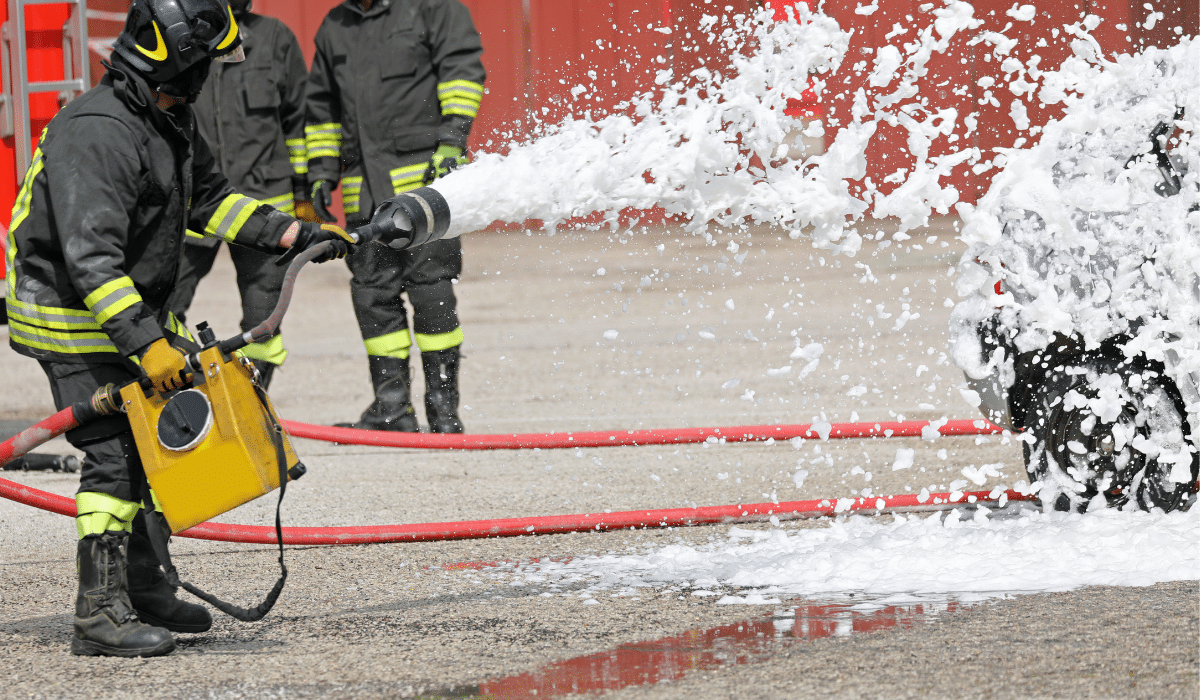Firefighters face unparalleled risks every day, battling blazes to save lives and property.
Yet, one of their most insidious threats comes not from flames, but from their protective gear and firefighting tools.
Per- and polyfluoroalkyl substances (PFAS) are a group of synthetic chemicals widely used in industrial and consumer products due to their water- and grease-resistant properties.
Unfortunately, these “forever chemicals” persist in the environment and the human body, posing significant health risks; especially to firefighters who are frequently exposed through firefighting foams and protective gear.
Here, we’ll examine the dangers of PFAS, current safety standards, legislative efforts like the PFAS Alternatives Act, challenges in transitioning to safer alternatives, and potential solutions to protect firefighter health.
Let’s break it down.
Related Article: Cancer Leading Cause of Death in Firefighters
Related Article: Breaking Down NFPA 1582 Requirements
What Are PFAS?
PFAS consist of a family of over 4,000 man-made chemicals used since the 1940s. Typically, they’re used in products such as non-stick cookware, waterproof clothing, and food packaging.
However, its their use in firefighting foams (Aqueous Film-Forming Foam, or AFFF), that make them dangerous to firefighters.
Their strong carbon-fluorine bonds make them highly resistant to heat, water, and oil. However, these bonds also prevent them from breaking down naturally, leading to bioaccumulation in humans and wildlife.

Why Are Firefighters at High Risk?
Firefighters face occupational exposure to PFAS through:
- Firefighting Foams (AFFF): Used in suppressing fuel fires, these foams contain high levels of PFAS, which can be inhaled or absorbed through the skin.
- Protective Gear: Many turnout gear manufacturers use PFAS-based coatings for water and oil resistance, leading to prolonged dermal exposure.
- Contaminated Fire Stations: PFAS from gear and equipment can accumulate in dust and water supplies within firehouses.
See American Cancer Society’s Publication on PFOA, PFOS, and Related PFAS Chemicals.
Health Risks of PFAS Exposure
According to the Firefighter Cancer Support Network and CDC, firefighters face a 9% higher risk of developing cancer and a 14% higher risk of dying from it compared to the general U.S. population.
The IAFF reported that 72% of line-of-duty firefighter deaths in 2023 were due to cancer, with risks extending into retirement due to the bioaccumulative nature of PFAS and other toxins.
Just take a look at a few of the serious health problems linked to PFAS exposure over the years:
– Cancer (testicular, kidney, prostate)
– Liver damage
– Thyroid disease
– Immune system suppression
– Increased cholesterol levels
– Reproductive and developmental issues
Firefighters already face higher cancer rates than the general population. PFAS exposure exacerbates this risk.
Current Safety Standards
Currently, there is no OSHA standard specifically for PFAS Protection. However, several agencies have taken steps to regulate PFAS. Take, for instance, the following:
– EPA’s PFAS Strategic Roadmap (2021): Aims to restrict PFAS discharges and set enforceable drinking water limits.
– CDC/NIOSH Research: Studies PFAS absorption in firefighters and recommends exposure limits.
– In 2024, Connecticut and Massachusetts passed laws that prohibit PFAS in firefighter turnout gear.
In the coming years, don’t be surprised if new regulations begin appearing regarding the use and exposure to these concerning chemicals.
The PFAS Alternatives Act
Introduced in 2023 to accelerate the phase-out of PFAS in firefighting foams and gear, the PFAS Alternatives Act hopes to fund research into safer alternatives.
It also mandates federal procurement of PFAS-free equipment, and supports fire departments in transitioning to non-PFAS solutions.
Although it hasn’t yet been adopted into law, the fact that a PFAS-specific bill was introduced shows that more and more, these chemicals are standing out as a serious threat to firefighters.
Challenges in Transitioning to Safer Alternatives
While the dangers of PFAS are clear, transitioning away from them presents several hurdles:
1. Performance Concerns
– PFAS-based foams and gear are highly effective in extreme fire conditions.
– Some alternatives may not provide the same level of protection.
2. High Costs
– PFAS-free gear and fluorine-free foams (F3) are often more expensive.
– Smaller fire departments may lack funding for replacements.
3. Lack of Clear Regulations
– While some states have banned PFAS in firefighting foams, federal mandates are still evolving.
– Manufacturers continue producing PFAS-laden gear due to demand.
4. Resistance to Change
– Firefighters trust existing gear that has proven reliable in life-threatening situations.
– Training on new alternatives requires time and resources.
Possible Solutions for a PFAS-Free Future
Despite challenges, several strategies can help reduce PFAS exposure in the fire service:
1. Accelerate Development of PFAS-Free Gear
– Investments in innovative materials (e.g., silica-based or plant-derived coatings) that match PFAS performance.
– Encourage manufacturers to adopt green chemistry principles.
2. Increase Funding and Incentives
– Federal and state grants should support fire departments in purchasing safer alternatives.
– Tax incentives for companies producing PFAS-free equipment.
3. Strengthen Regulations and Bans
– Expand the PFAS Alternatives Act to include stricter deadlines for phase-outs.
– Enforce mandatory PFAS labeling on gear and foams to increase awareness.
4. Improve Firefighter Training and Decontamination
– Train firefighters on proper gear handling to minimize exposure.
– Implement post-fire decontamination protocols (e.g., immediate gear cleaning and showering).
5. Advocate for Firefighter Health
– Fire unions and organizations should push for stronger occupational health protections.
– Support long-term health monitoring for firefighters with PFAS exposure history.
The Importance of NFPA 1582
First created in 1992 by the National Firefighter Protection Agency, the NFPA 1582 is a standard created to encourage fire departments to take a more proactive in reducing health risks, such as cancer.
The standard outlines a series of medical examinations, screenings, and physical challenges, to gauge the health of your crew. Through these regular physicals, a number of health risks can be detected long before they turn into major diseases, or even death.
Although not enforced nationwide, some state departments, such as the Ohio Department of Public Safety, require firefighters to meet the NFPA 1582 medical requirements.
It’s worth noting, however, that even in locations where no requirements exist, adhering to the standard significantly improves the health and safety of firefighters everywhere.
Bringing It Together
PFAS poses a serious threat to firefighter health, contributing to cancer and other chronic conditions. While regulatory efforts like the PFAS Alternatives Act are steps in the right direction, challenges remain in fully transitioning to safer alternatives.
By investing in research, improving regulations, and supporting fire departments in adopting PFAS-free solutions, you can reduce occupational risks and protect those who risk their lives to keep us safe.
Additionally, providing regular physicals and health screenings, like those called for in NFPA 1582, can help detect problems early, before it’s too late.
The time to act is now – before more lives become impacted by these persistent chemicals.
Stay In Compliance With Worksite Medical
In most cases, OSHA requires medical surveillance testing, and at no cost to employees.
Worksite Medical makes that program easier with mobile medical testing.
We conduct NFPA 1582 testing, silica exam physicals, on-site respirator fit tests (including N95 masks), audiometric exams, as well as pulmonary function tests and heavy metal lab work, and much more, right on your job site. We also keep accurate, easy-to-access medical records for your convenience. You’ll keep your employees at work, and stay ahead of OSHA inspections.
With Worksite Medical, a mobile medical testing unit — we can bring all the resources of a lab to you. Our certified lab technicians can perform both qualitative and quantitative respirator tests to ensure a perfect fit.
Protect your team and your workplace now with Worksite Medical. Not sure what you need? Try our medical testing wizard here.
Give us a call at 1-844-622-8633, or complete the form below to schedule an on-site visit or to get your free quote.
Convenient, Compliant Occupational Medicine. Worksite Medical – Let Us Come to You!
"*" indicates required fields




